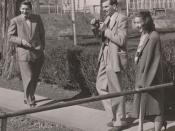Rey � PAGE \* MERGEFORMAT �3�
Eduardo M. Rey
Mr. King
ENC1102/Composition II
22 February 2010
Flannery O'Connor - Single Author Comparison
In her two short stories, "A Good Man Is Hard to Find" and "Everything that Rises Must Converge", O'Connor reveals much about her identity as writer. Both stories are told in a serious moral tone that set the mood for the reader. The theme of race is brought to life through violent self-realization moments by the main characters. Her writing style is vague and provides little concrete information to the reader up front. Yet, small ironic subtleties at the beginning seem to foreshadow events to come. Religion is not only part of the story, but a defining trait of the main characters. To follow, we compare these two works from the canon by this author in efforts to understand O'Connor's vision and persona.
Both stories were set in the south, during the civil rights movements (1955 - 1965).
This alone gave the reader an incline to the topics or themes that might surround the story. In "A Good Man Is Hard to Find", O'Connor introduces the story by saying "The grandmother didn't want to go to Florida. She wanted to visit some of her connections in east Tennessee and she was seizing at every chance to change Bailey's mind" (O'Connor, pg 364). The grandmother in this case is being described though her actions as a manipulative woman associated with people in Tennessee. During this time, African-Americans were more likely concerned about gaining equal rights rather than persuading someone named Bailey to visit Tennessee instead of Florida. Through the use of few words, O'Connor has developed the grandmother's character enough to expect certain behavior patterns from that character later in the story. In a similar fashion, in "Everything That Rises Must Converge", the first paragraph describes Julian's mother as a woman who "would not ride the buses by herself at night since they had been integrated, and because the reducing class was one of her few pleasures, necessary for her health, and free, she said Julian could at least put himself out to take her, considering all she did for him" (O'Connor, pg 400). Here, the resemblance of the characters becomes vivid. Both are Caucasian racist women, motherly figures that live during the civil rights movement. In contrast, the grandmother in the first story is blatantly manipulative, while Julian's mother is more self-righteous about her actions. I think this difference helps to set the pace and develop the plot for both stories. With the obviously manipulative character getting what's coming to her and the self-righteous character maybe getting what's coming to her slowly or indirectly.
The narrative mode used in both short stories is the third person omniscient point of view. This mode is suited for telling sweeping stories involving a surprise ending, so the mode becomes essential in conveying the themes of the two stories. The mode also helps to develop the plot. Both stories share this surprised ending plot structure, where in, or near the end of the story, one of the main characters has an intense moment of self-realization that is usually preceded or followed by severe acts of violence and/or death. In "A Good Man Is Hard to Find", in the last page of the story, the grandmother says to the misfit, "Why you're one of my babies. You're one of my own children!"(O'Connor, pg. 375). Shortly after, the misfit shoots her three times in the chest. Here, the grandmother has a moment where she realizes her bond with all humans - even the non-religious ones. In contrast, in "Everything That Rises Must Converge", Julian was the character who had a moment of self-realization. "Mother! He cried. Darling, sweetheart, wait! Crumbling she fell to the pavement. He dashed forward and fell at her side crying, Mamma, Mamma!"(O'Connor, pg 410). Julian recognized that he had been too hard on his mom for her beliefs. He seemed to focus only on the racist behavior of his mom, which I think affected him much more than his mom. This indirectly caused Julian to act out in harsh ways towards his mother in attempts to prove to her that her actions toward African-Americans were not right.
Race is a commonly occurring theme that rounds the characters in such a way that it defines their actions throughout the story. In "A Good Man Is Hard to Find", It seems to be the underlying reason behind the main characters actions and behaviors. Take for example when the grandmother interrupts a conversation with one of her grandchildren to say, "Oh look at the cute little pickaninny" (O'Connor, pg 366). The author uses the conversation to further develop and exploit the grandmother's character obvious racist beliefs. While in "Everything That Rises Must Converge", it seems to be embedded in the class conscious, self-righteousness of Julian's mother's actions. When Julian's mother says, "You remain what you are. Your great-grandfather had a plantation and two-hundred salves" (O'Connor, pg 402). This shows that she has a profound sense of pride for the way she was raised that overshadows and somehow justifies her racist comments and actions throughout the story.
The theme of race seems to be the most important to the author because she repeatedly concludes her stories by showing how different acts of violence can root from racist beliefs. O'Connor also uses race to set the serious topic mood in the exposition. I believe O'Connor was passionate about racism. She thought it was a serious topic so the stories are told with that underlying tone so as to never mislead the reader about the topic.
In both stories, characterization is accomplished most frequently through displaying the character's actions. Never does O'Connor bluntly say a particular character is racist. Although, using this method and through letting the character speak, it soon becomes apparent to the reader who the racist of the story is. Other common characterization methods used by the author include describing the character's appearance and getting the reactions of others. Very seldom does she reveal the character's thoughts. It's as if you are just along for the ride with O'Connor, like watching a movie with no inner monologues. The plot is exposed as the movie watcher is seeing a series of events take place, but has no clue what the characters are not saying out loud. The diction used by O'Connor also helped to shape the characters by using phrases in "A Good Man Is Hard to Find", like, "little niggers in the country don't have things like we do." (O'Connor, pg. 366). This word usage made me feel uneasy, and I believe that was the author's intent. To reveal phrases that are actually spoken by people with similar beliefs - to get the message across with a sense of discomfort.
These stories provide a glimpse of what O'Connor was passionate about. The important and controversial topic of race is difficult to tackle without taking sides. The elements of faith seem to be intertwined and poke out every chance they get. This topic was so much at the heart of her work that she made it nearly impossible for the reader to look past the racist behavior of the characters as they were being developed. However, in "everything that rises must converge", she also showed us what happens when individuals can't look past the ignorant behavior of others from a bigger perspective. I think the morbid styles of writing as well as the recurring themes of death and religion have bled over from her personal life. Her fight with Lupus brought her closer to death every day. This surfaced through moments of self-realization by the characters she wrote about, which were somehow probably related to her own moments of realization at times of "near-death" or "approaching death".
Works Cited
O'Connor, Flannery. "A Good Man Is Hard to Find." The Norton Introduction to Literature. 9th Ed. Ed. Booth, Hunter, Mays. New York: W.W. Norton & Company, 2006. 364 - 375. Print.
O'Connor, Flannery. "Everything That Rises Must Converge." The Norton Introduction to Literature. 9th Ed. Ed. Booth, Hunter, Mays. New York: W.W. Norton & Company, 2006. 400 - 410. Print.





